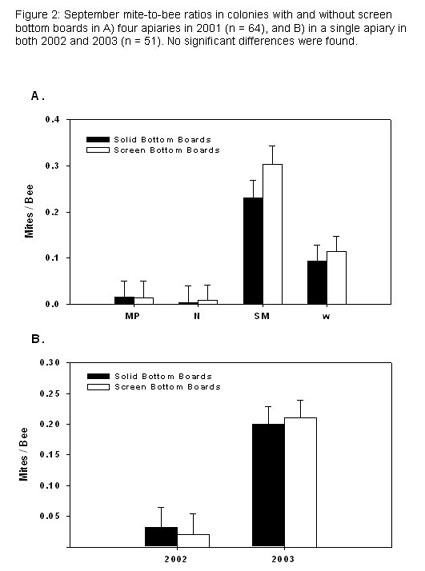
Screen bottom boards
Research: Many studies have shown that mites fall off of bees at relatively high rates, even when no chemical treatment is present. Many of these mites are still alive and manage to reacquire a host. It is commonly believed that mite populations can be suppressed if these fallen mites can be removed from the colony before they reacquire a host. The screen bottom board allows mites that fall from bees to fall out of the hive. Since they cannot re-enter the hive, they cannot re-acquire a host and they cannot contribute to the growth of the mite population.
Three years of research at Dyce Laboratory at Cornell University have shown that screen bottom boards have no effect on mite populations (figure 2). The reason for this is unknown, but it may be because the fallen mites are sick or old and no longer able to reproduce. However, research on the efficacy of screen bottom boards is mixed. Two other studies have shown numerical benefits from screen bottom boards, but the advantages were not statistically significant. One study has demonstrated a small but statistically significant benefit. Screen bottom boards do not appear to damage colonies. If effective mite knockdown agents can be identified, screen bottom boards may play a more significant role in mite management.
Mite-resistant stock
There are two stocks of mite-resistant bees available. One is descended from Russian queens imported to the U.S. The other is known as SMR stock (for suppressing mite reproduction) that was developed from bees already present in the U.S. Both are the result of work conducted at the USDA-ARS Honey Bee Breeding, Genetics and Physiology Lab in Baton Rouge, LA. Performance of commercially available variants of these stocks is mixed. However, stock improvement is ongoing, and you are strongly encouraged to try them.
Swarm prevention
A swarm from one of your colonies will establish a nest within foraging distance of its parent colony. Invariably, swarms will have some mites, and since they do not receive treatment to control the mites, they will eventually collapse and die. As they do, the colonies in your apiary will likely rob them and return to their nests with a large number of mites. Attend your bees, especially in the spring, when swarming is likely, and take all necessary steps to prevent it. Remember! A colony that you allow to swarm not only has created a future threat to your bees; it also will not produce nearly as much honey as if it had not swarmed.
Isolation
One way to reduce the rate at which mite populations rebound after treatment is to keep apiaries isolated from each other. Increasing the distance between apiaries reduces the chance of re-infestation from nearby collapsing colonies. A separation of three miles will provide some protection, while a separation of five miles is better. Isolation is not practical where colony density is high, and isolation cannot guarantee that your bees will not be re-infested because there may be wild colonies in the area. However, this method should not be overlooked when selecting apiary sites.
